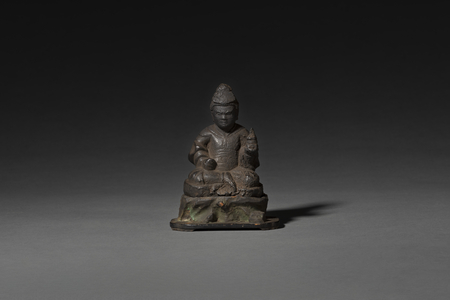Product Description
A bronze figure of seated Bishamonten (Vaiśravaṇa) with a fierce expression, wearing armour and holding a pagoda in his left hand, with a wooden stand and a modern metal stand
Figure: Japan 14th century Kamakura Period
Dimensions:
Figure: H. 11cm x W. 7cm x D. 4cm (4¼” x 2¾” x 1½”)
Figure and wooden stand: H. 13cm x W. 10cm x D. 6cm (5″ x 4″ x 2¼”)
Figure and metal stand: H. 25cm x W. 13cm x D. 6.5cm (9¾” x 5″ x 2½”)
This figure was originally mounted as a kakebotoke (hanging Buddhist image), which are generally circular votive plaques symbolising mirrors which represent the sacred body of kami (Shinto deities). They originate from the practice of Shinbutsu-shugo (syncretism of kami and buddhas) which was established in the Heian period. One of the few forms of Buddhist art unique to Japan, they can be found both at Shinto shrines and Buddhist temples and are presented as offerings to safeguard the compound and to ensure the prosperity of the Buddhist faith. In the Buddhist context they were hung from the eaves above the main entrance to an Image Hall, or above the frieze rail between the outer and inner sanctums of the shrine for the deity that protected the temple compound. They may also be used to represent hibutsu (hidden Buddha) which are not generally on show to the public.
Bishamonten originated in ancient Indian mythology as Kubera (Jp.: Kubira). He is the most powerful of the Guardians of the Four Directions (Shitenno, Four Heavenly Kings) and is the Guardian of the North quarter and as such is known as Tamonten (Listens to Many Teachings), he alone amongst the four is worshipped independently.
Bishamonten is the god of war and warriors and a dispenser of wealth and good fortune. He is considered a god of healing, with the power to save Emperors from life-threatening illness and to expel the demons of plague. He is also one of the Twelve Heavenly Beings (Juniten) and one of the Seven Gods of Good Luck (Shichifukujin).
His fierce expression and armour visually convey Bishamonten’s military role while the pagoda, with its South Asian origin as the funerary monument which enshrines the corporeal remains of the historical Buddha, symbolises the Buddhist teachings that he protects as well as being a reference to relic worship and reliquaries.
Kakebotoke of Bishamonten are far less common than those of Amida Buddha. For other examples of kakebotoke figures, see:
Anne Nishimura Morse et. Al. eds., Object as Insight, Japanese Buddhist Art and Ritual, Katonah Museum of Art, p. 46-47, pl. 9/10.
Nara National Museum, Bronze Sculpture of the Heian & Kamakura Periods (Special Exhibition), (Kyoto, 1976), p. 49-53
For more about kakebotoke and further examples, see Naniwada Toru, Nihon no bijutsu (Art of Japan), No. 284 Kyozo to Kakebotoke (Votive Buddhist mirrors and plaques), (Tokyo, 1990).
















